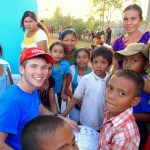global health
U.S. investments in global health research have saved millions of lives and prevented immeasurable suffering. And by working to detect, treat and eventually eliminate infectious diseases worldwide, we’re protecting our own country too. That cliché about diseases knowing no borders is unfortunately very true. All that alone should be enough to remain committed to the cause.
But a couple weeks ago, a new report from the Global Health Technologies Coalition (GHTC) offered another persuasive reason: U.S. funding for global health research and development (R&D) is good for the American economy…
The Pump Handle is on a holiday break. The following, which was originally published on July 8, is one of our favorite posts from 2016.
by Kim Krisberg
In 2005, the World Health Assembly adopted a revised version of its International Health Regulations, a legally binding treaty among 196 nations to boost global health security and strengthen the world’s capacity to confront serious disease threats such as Ebola and SARS. A decade later, just one-third of countries have the ability to respond to a public health emergency. That’s why Rebecca Katz thinks it’s time to get creative.
“How can we…
The percentage of Americans who reported cost-related barriers to health care dropped from 37 percent in 2013 to 33 percent in 2016 — a change that directly corresponds to insurance expansions under the Affordable Care Act, a new study reports. On the flip side, Americans are still more likely than peers in other high-income nations to face financial obstacles to health care.
The study is based on findings from a survey of patients and providers in 11 countries and one that the Commonwealth Fund has been conducting annually since 1998. Those 11 countries are: Australia, Canada, France,…
In 2005, the World Health Assembly adopted a revised version of its International Health Regulations, a legally binding treaty among 196 nations to boost global health security and strengthen the world’s capacity to confront serious disease threats such as Ebola and SARS. A decade later, just one-third of countries have the ability to respond to a public health emergency. That’s why Rebecca Katz thinks it’s time to get creative.
“How can we think creatively about incentives for countries to build the required public health capacity under international treaty obligations,” Katz, an associate…
I usually shy away from getting too personal in my work. But in the spirit of Thanksgiving and as a new mom, I was thinking about things for which I’m particularly grateful. One of the first things that came to mind as a public health reporter? Vaccines. So, in that vein, let’s celebrate some new and promising numbers on the worldwide effort to eliminate measles.
Last month, the Centers for Disease Control and Prevention released new data on progress toward measles elimination since 2000. That’s the year the United Nations adopted the Millennium Development Goals, which included a goal to…
As most people in any empirical or scientific field know, the gold standard for experimenting and establishing causality is the randomized controlled trial (RCT). In an RCT, subjects are randomly assigned to one of two conditions: an experimental group or a control group. The experimental group receives the intervention or drug and the control group receives standard care or a placebo (basically, the equivalent of the status quo). The idea behind the randomized controlled trial is to control the circumstances surrounding the experimental question as much as possible. This allows researchers…
It seems simple enough – a proliferation of donors in global health means more money to solve some of the world’s most pressing health issues. Right? Not exactly. A lot of new evidence is coming out that suggests that the lack of coordination of different funding sources can be a burden and perhaps a detriment to global health. And the way that traditional funders think about the locus of health spending in countries to which they donate may not even be entirely accurate. As a recent report from the Center for Global Development In fact, as the report finds, most funding for health is…
The association between financial hardship and medical care isn’t new. Even in wealthy countries such as the U.S., medical bills contribute to a large percentage of personal bankruptcies. Now, a new global study finds that dental care can also contribute to families falling into poverty and being left with fewer financial resources for basic necessities.
In a study published today in the journal PLOS ONE, researchers found that up to 7 percent of households surveyed in 41 low- and middle-income countries had experienced catastrophic dental care expenditures in the last month. To conduct the…
Worldwide, the numbers of children who die before their fifth birthdays is on the decline. Still, millions of children are being lost to diseases and complications that are completely preventable.
In a study published earlier this week in the Lancet, researchers examined the reasons behind the 6.3 million deaths among children younger than 5 in 2013 — a number that’s significantly less than the 9.9 million such deaths that occurred worldwide in 2000. Nearly 2 million of the 2013 child deaths were due to complications from preterm birth and pneumonia, both of which were leading causes in 2000…
It looks like a simple piece of paper and it’s nearly as cheap, ideally costing just pennies. But despite its small size, it’s poised to make an enormous impact and potentially save thousands of lives.
It’s a new test to spot counterfeit versions of the drug artesunate, which is one of the most important drugs used to treat malaria, a mosquito-borne disease that affects hundreds of millions of people every year. Based on the science of microfluidics, researchers at Oregon State University developed an easy-to-use and inexpensive testing kit that patients and health care providers can use to…
Unfortunately, it’s not too terribly surprising that diseases of the developing world don’t attract as much research attention as diseases common in wealthier countries. However, a new study not only underscores that trend, it actually found zero relationship between global disease burden and health research.
Designed to identify the reasons behind global health research disparities, the study compared the global disease burden (defined as healthy life years lost to disease or disability) of 111 diseases against relevant research articles using data from the World Health Organization and the…
One of the Millennium Development Goals -- a set of goals to improve global well-being by 2015 -- is to reduce by two-thirds the mortality rate of children under age five. The good news for MDG progress is that the under-five mortality rate has been cut nearly in half, from 90 deaths per 1,000 live births in 1990 to 48 in 2012. The bad news is that 6.6 million young children still die every year, and those deaths are concentrated in the world's poorest regions. Eight-one percent of these deaths occurred in Sub-Saharan Africa and Southern Asia, many of them in babies' first 24 hours of life.
A…
Student guest post by Brandon Woods
A Dangerous Paradise
From jungles with jaguars to crystal blue lakes with freshwater sharks, Nicaragua is one of the most beautiful and dangerous countries in Central America. The brilliant biodiversity attracts millions of tourists each year and the looming volcanoes that pepper the landscape can be an exciting yet unsettling sight. However, in reality much of the danger in Nicaragua comes from the risk of infectious diseases. For example, if you’re planning to travel to this tropical paradise anytime soon, the Center for Disease Control (CDC) states that…
Student guest post by Jack Hamersky
After successfully completing a job interview I had the opportunity to take the next step in my employment process: taking a Tuberculosis or TB test. I have received the test before but never really understood the point of testing for a disease no one ever sees in my community. I always thought, “Why not focus all this effort and money on more prevalent infectious agents such as Ebola or HIV?” You know, focus on something important. So, as the nurse called me in from the waiting room I began to curse that hard little bubble that would soon be…
At Wonkblog, Brad Plumer highlights a new NBER paper that's disappointing to those who hoped that distributing cleaner cookstoves in India and other countries would be an easy way to improve respiratory health and help slow global warming. Many low-cost, traditional cookstoves belch soot, which is bad for the lungs of people who spend long hours near the stoves and for the ice that melts more quickly when soot particles settle on it. Cleaner stoves would improve respiratory health and could run on less fuel, and these changes could be of particular benefit to women, who often spend hours each…
I rarely write about climate change. As much as it's been hashed out amongst climate scientists, and even many of the former "climate skeptics" have now changed their tune, I readily accept that climate change is happening, and is happening largely due to human activities. More importantly for my field, climate change is also having effects on human health in a number of different ways, from the movement of insect vectors into new areas, to warming of the seas leading to more extreme weather conditions, to the loss of coral reefs and the freshwater that these reefs protect from the…
Malaria is one of mankind's most ancient scourges. A century after the discovery of its cause, various species of the parasite Plasmodium, humanity still remains in its deadly grip in many areas of the world. Malaria is estimated to have caused 225 million illnesses and almost 800,000 deaths in 2009, making it one of the top infectious disease killers. Many of these deaths occurred in children under the age of five.
Shah traces the history of malaria from the introduction of the parasite into the human population to modern-day controversies about malaria treatment, research, and funding. It'…
The saying "demography is destiny" reportedly dates back to 19th-century social scientist Auguste Comte, and it's still popular among journalists. Earlier this year, for instance, Alan Wheatley of Reuters warned about the challenges Asian countries (especially Japan) will face as over-60 residents make up ever-larger shares of their populations. His article also touches on the challenges for countries that face the opposite problem: a large proportion of young residents, or "large cohorts of angry, unemployed young men" prone to causing turmoil.
A recent Council on Foreign Relations report…
The Kaiser Family Foundation has just released a report on the future of global health journalism, and it's not surprising to hear that the traditional model of covering global health is crumbling. KFF commissioned journalists Nellie Bristol and John Donnelly to conduct this research, and their interviews with 51 stakeholders found that challenges abound. Budget pressures on mainstream news media have reduced the number of reporters on this beat and restrained their ability to travel. Freelancers struggle to find receptive outlets for their stories and stretch paltry story payments to cover…
In the winter of 1999, I stood in an outpatient clinic in a pediatric hospital in New Delhi and listened to a father sobbing over the paralysis of his only son. He was a farmer and lived in Uttar Pradesh; counting walks, minibuses and trains, it had taken him 24 hours to get to the hospital. He had carried the toddler the entire way.
His son had gotten the drops, he insisted: Every time the teams came to his neighborhood -- which they did three, four times each year -- he or his wife had lined up all their children, the boy and his older sisters. His son had had 11, 12 doses, the man said.…

